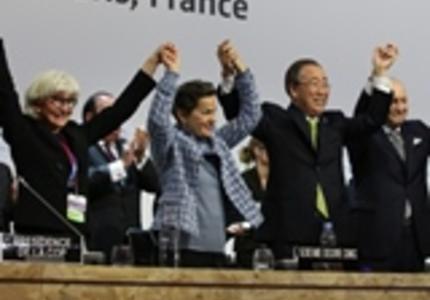The objective of this note is to very briefly describe the key elements of the current negotiation of the Paris Climate Agreement. These are points both still under negotiation, and whose successful resolution could help to ensure the value of the Paris Agreement.
- Universal participation. Both the UNFCCC and the Kyoto Protocol are universal agreements. However, they do not contain precise obligations for all countries, and they are based on the bifurcated system of annexes, containing developed and developing countries. The Paris Agreement aims to be ‘applicable to all’ countries (see point 3 for more detail). With 161 countries already having submitted their Intended Nationally Determined Contributions (INDCs), representing 91% of global GHG, there is already a positive momentum towards an agreement with undertakings by almost all countries. It will be important also that the agreement is adopted in Paris without procedural difficulties that could be interpreted as a lack of consensus behind the agreement. Finally, the entry into force of provisions of the agreement should be set such as to ensure that a sufficiently high threshold must be crossed in terms of participation (ratification) for the agreement to enter into force.
- A legal agreement, with some binding elements and some non-binding elements. Although universal in nature, the Copenhagen Accords were a non-legally binding agreement. The objective of Paris is to negotiate a legal agreement, i.e. a treaty under the Vienna Convention on the Law of Treaties (although it may be called something else than a treaty), complemented by a series of COP decisions. This note therefore speaks about the ‘Paris Agreement’ in the broad sense, namely the legally binding agreement and associated COP decisions. This former could contain binding procedures to participate in collective mechanisms related to: a) the preparation, submission, and adoption of measures to implement NDCs; b) their regular revision (see point 5 below); and c) transparency regarding their implementation and achievement. It seems likely that the legal obligation viz. NDCs will be an ‘obligation of conduct’ rather than of result. Countries could be obliged to implement their NDC, rather than to achieve it to the letter. There is still much discussion about the strength of this expression of the obligation to implement NDCs.
- The Paris Agreement should be applicable to all. However, there is still a wide diversity of national circumstances. The challenge thus is to create an agreement that moves beyond the UNFCCC’s Annexes, takes into full account the spectrum of national circumstances, but still provides sufficient space for differentiation. It seems likely that there will not be an overarching solution to differentiation (i.e. like the definition of new Annexes). Rather, it seems likely that differentiation will be given specific and possibly different treatment in each element of the agreement (mitigation, adaptation, finance, etc.). Secondly, it seems likely that the system of differentiation will be based much more on ‘self-differentiation’ within a common but flexible framework. Common principles and political scrutiny can help to ensure that within this flexible framework, similar countries undertake similar responsibilities. Countries will need thus to be able to look at the overall agreement, and form a judgement regarding its fairness.
- The 2°C goal. The Cancun Agreements adopted the goal of limiting warming to below 2°C. However, a target expressed in temperature may be less concrete and impactful than a more operational target, expressed e.g. in terms of global emissions. There have thus been many calls for the Paris Agreement to ‘operationalize’ the 2°C goal. This could include a mid-century emissions level, and/or longer-term objectives such as the transition to low-emissions and resilient economies during the course of this century. The level of precision of the objective is an important criterion. Some countries are concerned that the definition of a global goal could lead eventually to a more explicit system of top-down burden sharing. For this reason, it seems likely that the global goal would need to be combined with recognition that countries will take different nationally determined pathways towards this collective objective, based on their different national circumstances.
- Cycles of action to keep the 2°C target in reach. As noted above, 161 countries have presented INDCs, representing already a major success. The INDCs accelerate and consolidate action on climate change; however they are not sufficient to hold warming to below 2°C. For this reason, many are calling for the Paris Agreement to establish a mechanism whereby countries will regularly increase their national ambitions in a coordinated way. There are a number of key elements here. The Paris Agreement could define the date for the first such revision (i.e. 2020, in order to ensure that ambitions are not locked in). The Paris Agreement could define the periodicity for revisions (ideally, every five years). It seems likely that the Paris Agreement could also establish a mechanism of regular global stocktaking, during which countries would collectively assess global progress on mitigation, adaptation, technology and finance, before preparing their next contribution. It could also be important to clearly link this mechanism of cycles to the global objective of limiting warming to 2°C. Future contributions could also be based on an invitation for each country to develop a mid-century low-emissions strategy, which would situate the contribution in the context of the profound, long-term transition that each country will need to make towards a low-emissions economy.
- Adaptation. Adaptation is growing in importance, as the impacts of climate change become more and more apparent. Traditionally, the UNFCCC has been somewhat of a mitigation-centric regime. Many are calling for adaptation thus to be placed on an equal footing with mitigation. Concretely, this could mean defining a global goal for adaptation, namely the objective that all societies transition towards resilient economies, given the level of warming that can be expected in coming decades with the objective of limiting warming to 2°C. All countries could also be invited to develop national adaptation strategies and submit these to the international community. Finally, the Paris Agreement could significantly strengthen the system of information sharing and tracking of adaptation progress. While this is a long-term endeavour, the Paris Agreement could set the direction towards much greater transparency and understanding of the state of adaptation around the world, and subsequent technical work could develop the concrete modalities.
- Loss and damage. Even with strong action to limit emissions and adapt to climate change, it is likely that some societies will face significant climate impacts, potentially beyond their capacity to adapt. This had raised calls for the development of a ‘loss and damage’ mechanism. This concept has not really been fleshed out. Issues of ‘liability’ are scientifically, legally and politically very complex. However, the Paris Agreement could include a recognition of the reality of ‘loss and damage’ if insufficient action is taken to adapt and mitigate, and, as a consequence, the need to strengthen international solidarity in the face of climate impacts. Such solidarity can be thought of in terms of disaster response, the establishment of early warning systems, regimes for migration management, etc.
- Finance. Finance is traditionally a key element of the negotiations, and indeed is a crucial lever of the transition to low-emissions, resilient economies. The Paris Agreement would need to resolve a number of issues. Firstly, developed countries will need to demonstrate sufficient progress and clarity on the pathway toward the objective of raising 100 billion USD by 2020. A broad combination of improved tracking and accountability, further national pledges for climate finance, and contributions from multilateral development banks will need to be perceived as sufficient and credible. Secondly, the Paris Agreement could define the framework for post-2020 climate finance. This includes basic questions like the establishment, or not, of a quantified collective objective for post-2020 climate finance, incumbent on a group of countries. The phrase ‘group of countries’ masks a second important issue, namely that of responsibility: who should be responsible for providing climate finance post-2020? Here it seems likely that developed countries will remain at the forefront, with potentially an invitation upon other countries in a position to do so to provide climate finance. Finally, it is increasingly apparent that adaptation finance is neglected in comparison to mitigation finance. Many developing countries are therefore calling for an adaptation specific objective to be established in the Paris Agreement. Finally the Paris Agreement could recognise that the policy object of climate finance must be to initiate a broad transition within the financial sector, away from high-carbon towards low-carbon investments. This could be expressed in terms of a global goal for climate finance, e.g. a goal of progressively greening all relevant investment flows.
- Transparency and accountability. A crucial role for the international regime is to create trust in collective action, by ensuring that countries are adhering to their promises and providing a picture of the scale of global progress (hence the interest in a global stocktaking developed in point 5). An important focus in the negotiation of the Paris Agreement is therefore the issue of ‘transparency and accountability’. The Cancun Agreements developed a new and strengthened transparency system, which nonetheless has some weaknesses. A key issue in the negotiation is whether the current system, bifurcated between developed and developing countries, should be merged into a single system. While there seems to be increasing convergence in this regard, it remains a difficult and sometimes politicized negotiation. It seems that the Paris Agreement could establish a general principle that all countries should report on the implementation and achievement of their contribution. It could establish a principle that subsequent methodologies will be developed to ensure an agreed, flexible system for accounting for the different types of contributions that countries have submitted. Finally, the nature of this system would remain facilitative and non-punitive; it should act more as a system of ‘early warning’ to ensure that the international community can track in a forward-looking way countries’ progress towards their contributions.
- Non-state actors. In the run-up to Paris, a range of non-state actors, notably businesses and local governments, have been developing their own initiatives to tackle climate change. This welcome development reflects the enormity of the problem, and the multiple scales on which action is required. It would be a mistake to think that state and non-state action can substitute each other; both are required; and both can be mutually reinforcing. The Paris Agreement could recognise the action that has been taken and pledged, and establish the basis for a system for making sure that the effort to mobilise non-state action persists after Paris, including through better transparency and accountability. Recognition that the UNFCCC cannot be expected to deal with climate change alone, and that other relevant fora and coalitions must contribute, could help to facilitate the broad range of action required after Paris. In this context, the UNFCCC would remain the centre for state action, and provide an overall direction and coherence to the multitude of actions taken in other contexts.
Image source : Pixabay
Climate International Negociations: what for?





